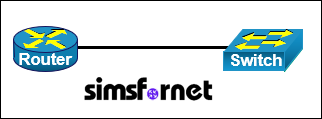Device Security 1
Topology

Tasks:
A network administrator is tasked with securing the router and switch of a company's network. The company wants to implement the following security measures:
- Configure a local username and password to prevent unauthorized access.
- Username:: John Doe
- Password: StrongPass#123
- Privilege level: Exec mode
- Encrypt the password instead of storing it in plain text.
- Secure console access by requiring authentication before granting access to configuration mode.
- Use local username for authentication.
- Automatically log out the user after 2 minutes of inactivity.
- Prevent log messages from interrupting commands.
- Enable type 7 password encryption to prevent passwords from being stored in plain text.
- Secure the privileged EXEC mode with password "StrongEnable#123" using MD5 hashing encryption.
Solution:
Task 1: Configure a local username and
password to prevent unauthorized access.
- Username: JohnDoe
- Password: StrongPass#123
- Privilege level: Exec
mode
- Encrypt the password instead of
storing it in plain text.
To ensure that only
authorized personnel can access the network devices, we configure local users.
On Router:
Router# configure
terminal
Router(config)# username JohnDoe privilege 15 secret StrongPass#123
On Switch:
Switch# configure
terminal
Switch(config)# username JohnDoe privilege 15 secret StrongPass#123
The username JohnDoe privilege 15 secret
StrongPass#123 command creates a user account with privilege level 15 (full
administrative access).
The secret keyword encrypts the password
using MD5 encryption instead of storing it in plain text.
Task 2: Secure console access by requiring
authentication before granting access to configuration mode.
- Use local username for
authentication.
- Automatically log out the user
after 2 minutes of inactivity.
- Prevent log messages from
interrupting commands.
On Router:
Router(config)# line
console 0
Router(config-line)# login local
Router(config-line)# exec-timeout 2 0
Router(config-line)# logging synchronous
Router(config-line)# exit
On Switch:
Switch(config)# line
console 0
Switch(config-line)# login local
Switch(config-line)# exec-timeout 2 0
Switch(config-line)# logging synchronous
Switch(config-line)# exit
line console 0: configures the console line.
login local: Uses local
users for authentication.
exec-timeout 2 0: Automatically logs out the user
after 2 minutes of inactivity.
logging synchronous: Prevents log messages from
interrupting commands.
Task 3: Enable type
7 password encryption to prevent passwords from being stored in plain text.
By default,
passwords configured on Cisco devices (e.g., console, VTY, enable password) are
stored in plain text in the device’s configuration files (running-config and
startup-config). This is a major security risk because anyone with access to
these files can read and steal passwords.
To prevent passwords
from being stored in plain text, we use the following command:
On Router:
Router(config)#
service password-encryption
On Switch:
Switch(config)#
service password-encryption
service
password-encryption: Encrypts passwords stored with the password keyword (Type 7 encryption).
Passwords stored with secret are already
encrypted using MD5 (Type 5).
Task 4: Secure the
privileged EXEC mode with password "StrongEnable#123" using MD5
hashing encryption.
We need To prevent
unauthorized access to Privileged EXEC mode (enable mode) using MD5 encryption.
On Router:
Router(config)#
enable secret StrongEnable#123
On Switch:
Switch(config)#
enable secret StrongEnable#123
enable secret
StrongEnable#123: This command creates an enable password and the "secret" keyword encrypts it using MD5
encryption.
Now exit
configuration mode and save the configuration.
Router(config)# end
Router# write memory
Switch(config)# end
Switch# write memory
Important Note:
Cisco Type 7
encryption is not highly secure and can be easily cracked using online tools.
It only prevents casual users from reading passwords in plain text.
The secret keyword in command stores
passwords using MD5 hash encryption, which is much more secure.
Best Practice
Recommendations:
- Always use service password-encryption to prevent casual viewing
of passwords.
- Avoid using enable password (plain text) and use enable secret instead for stronger
encryption.
- For maximum security, use AAA
(Authentication, Authorization, and Accounting) with external
authentication servers like RADIUS or TACACS+. These are high level
concepts and their configuration is not included in the current CCNA exam.
Packet Tracer File
Clicking this button will begin the download of a ZIP file. Inside the ZIP file, you'll find a Packet Tracer Activity (.pka) file, which will automatically track your progress as you configure the network.

